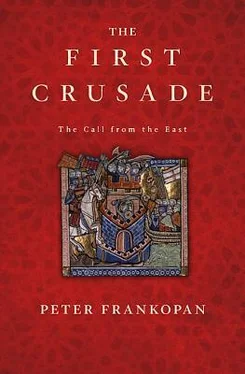Despite the enthusiasm generated by Bohemond’s call to arms, his assault on Byzantium was an abject failure. Setting out in October 1107, Bohemond first moved on Epirus in the south-western Balkans, a region Alexios had already had to defend twice before during his reign. Replicating the tactics that had devastated Robert Guiscard’s force in 1084–5, the emperor made alliances with Italian city-states, cutting western supply lines back to Italy and imposing an effective land blockade. The noose was then tightened remorselessly. Having set off with grandiose plans to dispose of Alexios, seize Constantinople and then march east to join up with Tancred at Antioch, Bohemond found himself ground into the dust. With his men dying from disease and hunger, he eventually had no other choice than to sue for peace. At a humiliating meeting at Diabolis (or Devol), in modern Albania, he accepted Alexios’ terms, which are recorded in full in the Alexiad .
Bohemond was forced to recognise that he had made an agreement with the emperor when he passed through Constantinople in 1097, though he also stated that this had been violated as a result of ‘certain unexpected events’. He admitted that his attack on Byzantium broke the terms of the agreement, but while he had betrayed Alexios, this was the result of temporary insanity. He stated that he had finally regained his senses. 28
Bohemond now paid new homage: he once again formally became the liegeman not only of Alexios but also of his son and heir, the young prince John Komnenos. He was to defend their lives with honour and resolution, his promise to do so set solid ‘like a statue hammered out of iron’. ‘Whatever happens’, he promised, ‘I will not violate this; nor shall there be any reason or method, manifest or obscure, that shall make me appear to be a transgressor of the articles of this present covenant.’ 29
The treaty agreed at Diabolis went on to delineate which provinces, towns and villages belonged to the Byzantine Empire, and over which it claimed jurisdiction. The military district of Tarsos, and the whole of the district of Cilicia between the rivers Kydnos and Hermon were subject to the emperor; Laodikeia and the surrounding area was identified as Byzantine, as were Aleppo and other towns in northern Syria and in the Caucasus. 30The purpose of listing these regions was to establish clearly which areas were subject to Alexios’ authority – either de facto, or de jure . This went beyond redrawing the boundaries of land that had been subject to imperial authority before the First Crusade, for in many cases, notably in Cilicia, the Byzantine military had also had to resist and repel forces led by Bohemond and Tancred that had taken control of territories recovered from the Turks. Bohemond agreed to restore possessions to the empire, and to wage relentless war on the emperor’s enemies and rivals – including his nephew Tancred – until they relinquished towns that rightfully belonged to Byzantium. 31
The question of Antioch, the jewel of the Byzantine east, was finally resolved, with Bohemond agreeing to cede it to the empire. The Norman was to retain a life interest in the city, holding it as an imperial governor on behalf of Alexios until his death, whereupon it would pass ‘to the empire of New Rome, the Queen of Cities, Constantinople’. However, the emperor retained the right to claim it before this point, should Bohemond fall short in any way of his obligations as ‘servant and liegeman’. 32It was also agreed that Antioch was to have an Orthodox patriarch and that the city would follow the Greek rite; this was to be binding in perpetuity. 33This reversed the appointment of a western cleric following the expulsion of John the Oxite in 1100, when Bohemond had set about cementing his control of the city. 34
While Tancred continued to cause trouble in the east – he had yet again moved into Cilicia when Byzantine troops were recalled from the region in 1107 – Alexios rewarded Bohemond with the high title of sebastos and a fat annual salary, and appointed him formally as Antioch’s governor. This was not a concession; Alexios knew that his best chance of regaining Antioch lay in Bohemond doing so as his agent. 35
All these terms were accepted by the Norman, who gave a further, sweeping commitment to the emperor: ‘I will abide by all the undertakings I have given ... and in no way whatsoever will I breach my oath, break my promises or evade my responsibilities. In thought and deed, I, and all my men, will do everything in my power to help and honour the empire of the Romans.’ 36The treaty was concluded with Bohemond swearing to honour the terms in the name of Christ, while placing his hand on the Holy Gospels and in the presence of some of the most important relics in Christendom. These included the Cross of Christ, the crown of thorns and, significantly, the spear that pierced Jesus on the Cross – a tacit admission that the lance recovered so conveniently in Antioch in 1098 was a fake. 37
This was a crushing victory for Alexios. The legitimacy of his claims had been established incontrovertibly. But it was Antioch, ‘the jewel of Asia Minor’, that provided the crowning glory. For the knights of the First Crusade, the culmination of the expedition came with the capture of Jerusalem in 1099. For Emperor Alexios, it came nine years later with the Treaty of Diabolis. The Crusader army had helped Byzantium to recover Nicaea and the coast of Asia Minor. But the agreement reached with Bohemond marked the point at which the emperor’s appeals for help from the west were finally resolved – it vindicated his policies, as well as his reign.
In practice, however, Alexios’ success looked less assured. His reputation in the west had been severely damaged in the wake of the expedition to Jerusalem. Doubtless there were many Crusaders who still respected the emperor – and the lavish reception given to Robert of Flanders and Robert of Normandy as they passed through Constantinople on their way home from Jerusalem was designed to leave them with a favourable impression of Byzantium. 38Alexios had also taken care to ransom knights captured by the Muslims, and to treat survivors of the doomed 1101 expedition with great generosity. 39However, the two earliest written accounts of the Crusade both painted an overwhelmingly negative picture of the emperor.
The Gesta Francorum was particularly poisonous in its portrayal of Alexios. The emperor, wrote its author, rejoiced when he learnt that Peter the Hermit and his force had been utterly smashed at Xerigordos. 40He was wretched and wicked, ordering his men to kill Crusaders whenever they had the chance. 41Alexios was ‘troubled in mind and fairly seething with rage, and planned how to entrap these Christian knights by cunning and fraud; but by God’s grace, neither he nor his men found place or time to harm them’. 42The emperor was a fool and a knave. At Nicaea, he ensured that Turks were spared and brought to Constantinople so they could be briefed and sent back to fight against the western knights. At every step of the way, Alexios had sought to hinder the expedition to Jerusalem. 43
The account of Raymond of Aguilers, who travelled as part of the contingent of Raymond of Toulouse, also did not spare the emperor. Alexios, he wrote, bribed agents to deliver rosy reports about Constantinople as the army marched towards the capital on their way east; his words of friendship were without meaning or substance. 44In fact, the emperor was an out-and-out liar, declared Raymond. He made promises at Nicaea about founding a hospice for needy Franks and giving lavish rewards to the Crusaders. ‘The Franks trusted these sincere words and prepared for surrender. But once in possession of Nicaea, Alexios afforded the army such an example of gratitude that as long as he might live, people would ever revile him and call him a traitor.’ 45Central to this was the sense that the emperor had sent the Crusaders into Asia Minor and towards Antioch; according to Raymond, Alexios had knowingly sent the westerners to their doom. 46
Читать дальше











